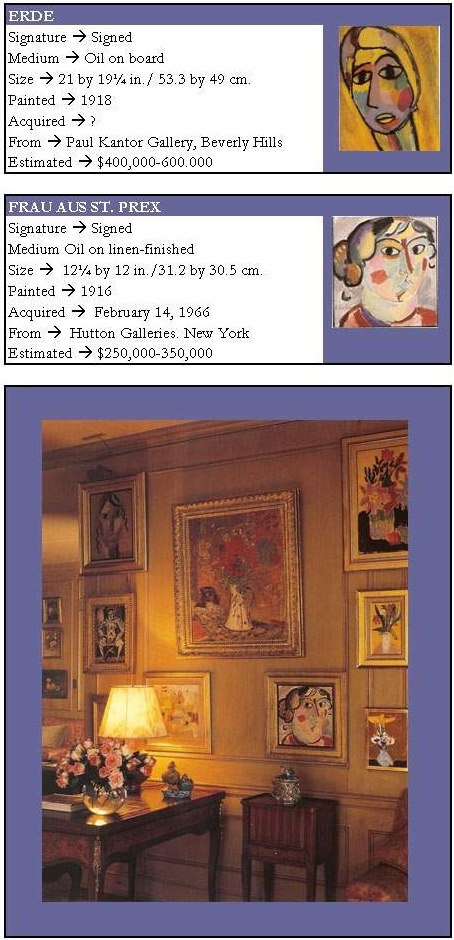| The Jawlenskys
|
|
Angelica Jawlensky, Locarno September 1990: |
As one looks at die Jawlenskys in the Garbo Collection.
It is clear that her passion as for works painted between 1915 and 1918. Drawn from the three major subs of paintings executed during these years. We Garbo paintings reflect the evolution of the artist's interests and style during a critical period in his life.
The colorful Blumenstilleben and the Variation Versonnen date from 1915. Just after Jawlensky's dramatic move to St. Prex, where he began a new life and new work. Both arc particularly beautiful and harmonious examples of Ks series of still lifes and variations. Frau aus St. Prex and Variation Vorwinter, 1916, clarity Jawlensky's search for simpler and consequently more abstract forms in the series of inner landscapes.
Frau aus St. Prex is an intriguing transitional work, painted just 1)((61'e Jawlensky began the series of Mystical Heads butt also recalling his portraits 1)c161, the War. The three Mystical Heads Erde, Profil and Schwarze Lochen bear witness to a new style, one in which, through simplified form, a strong yet subtle expressiveness is achieved. Together, the Garbo paintings repersent a pivotal moment in Jawlensky's life, a period when, after an inner crisis, he began to create something new, full of energy, hope and harmony.
Gray Horan, New York August 1990: |
There was a hint of humor in much of what she did. She grouped the lineal , highly-colored Jawlensky portraits on the wall, across from the two softer Renoirs. She would ask you what you supposed they said to one another.
Cécile de Rothschild, Paris August 1990: |
.her taste reflected her personality, and her eye was instinctive and sure. She alone chose the paintings front those offered to her, always independent in her opinions and never hesitant in her judgment. Adventurous and far-sighted, she was not influenced by fashion, acquiring the Jawlenskys well before his work was widely sought after, for example. She taught me a great deal about how to look at art
About Alexej Georgewitsch von Jawlensky: |
Jawlesnky (March 13, 1864 March 15, 1941) was a Russian expressionist painter active in Germany.
He was a member of the New Munich Artist's Association (Neue Künstlervereinigung München), the Blue Rider group (Der Blaue Reiter). He was also a member of the Blue Four. He was born in Torzhok, a town in the department of Tver, Russia. It was the fifth child of Georgi von Jawlensky and his wife Alexandra (née Medwedewa). His family was aristocratic. At the age of ten he moved with his family to Moscow.
After a few years of military training, he became interested in painting.
He was visiting the Moscow World Exposition c. 1880.
In 1896 he moved to Munich where he met Wassily Kandinsky and Marianne von Werefkin.
Those aere other Russian artists and they helped form the Neue Künstlervereinigung München. His work in this period was lush and richly coloured. But later moved towards abstraction with a simplified and formulaic style in a search to find the spiritual.
He died in Wiesbaden, Germany on March 15, 1941.In November of 2003 his Schokko (Schokko mit Tellerhut) sold for US$8,296,000


* Special thanks to Patrick from England for creating and aranging this section * |
| |
| |